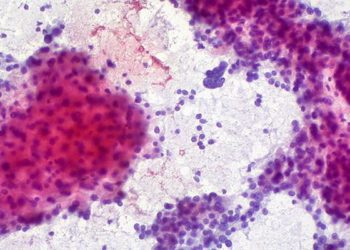Combination therapy effectively treats hepatocellular carcinoma in mice [PreClinical]
1. When combined with hepatic artery ligation, the current treatment for hepatocellular carcinoma (HCC), tirapazimine (TPZ) was found to decrease tumor recurrence in mice.
2. TPZ and hepatic artery ligation together led to almost complete necrosis of tumor cells in mice with HCC.
Evidence Rating Level: 3 (Average)
Study Rundown: Transarterial chemoembolization (TACE) is the current main treatment for patients with HCC, however it is only temporarily effective with a high recurrence rate and low survival rate. This treatment works by starving the tumor cells of key nutrients and oxygen for survival, however not all tumor cells experience lethal oxygen deprivation. Because of this incomplete tumor cell death, the researchers in this study tested the effect of a similar technique in mice along with TPZ, a hypoxia-activated cytotoxic agent. The hope was that this combination therapy would effectively kill off all tumor cells, including ones that still survived following TACE.
This combination therapy was tested in hepatitis B virus X protein (HBx) transgenic mice, a mouse model that spontaneously develops HCC. After confirming the efficacy of hepatic artery ligation and determining the optimal concentration of TPZ, a combination of these two therapies were tested. These mice showed near complete necrosis of tumor cells with a minimal effect on noncancerous cells. An MRI of the liver of these mice taken a few months after treatment demonstrated that there was no recurrence of the tumor.
This treatment is promising due to its ability to kill more cancerous cells than the current treatment used, and could potential prevent or delay remission. Despite these results, there were many differences in the procedure formed on mice and humans, as well as other differences that are not directly translatable. Although more steps will need to be taken to determine whether this method will increase the efficacy of HCC treatment, this study provides a new potential treatment to help increase survival in patients with HCC.
Click to read the study in PNAS
Relevant Reading: Molecular mechanism of tirapazamine (SR 4233, Win 59075)-induced hepatocyte toxicity under low oxygen concentrations
In-Depth [animal study]: Using HBx transgenic mice, the left hepatic artery was ligated (L-HAL) and measures of hypoxia were assessed. Erythropoietin and HIF-1α levels were found to be elevated through RT-PCR and Western blotting, respectively. These effects were only noted in the left lobe of the liver. After confirming the efficacy of L-HAL, a variety of doses of TPZ was tested for optimal efficacy, and 3 mg/kg was found to be best tolerated in these mice.
The effect of a combination of treatments was then tested. Mice containing palpable tumors were injected through their tail veins with either 3 mg/kg TPZ, saline, or 10 mg/kg doxorubicin, the current treatment used alongside HAL. They then underwent L-HAL and their tissue was stained with hematoxylin and eosin to visualize cell necrosis. Whereas only around 5% necrosis was observed in mice treated with doxorubicin, the TPZ-HAL treated mice showed >99% necrosis. In addition, whereas no histopathological changes were noted in the control mice, 99% of the cancer cells treated with TPZ-HAL underwent hepatic necrosis.
Finally, the long-term effects of this combined treatment were tested using contrast-enhanced liver MRI. Once again, cell necrosis was noted in the tumor cells specifically. After following these mice for 120 days, their tumor did not grow back and instead became cystic. Although no other tumor regrew in that location, some tumors were noted in alternate lobes of the liver.
Image: PD
©2016 2 Minute Medicine, Inc. All rights reserved. No works may be reproduced without expressed written consent from 2 Minute Medicine, Inc. Inquire about licensing here. No article should be construed as medical advice and is not intended as such by the authors or by 2 Minute Medicine, Inc.



![Endostatin directly binds androgen receptors to treat prostate cancer [PreClinical]](https://www.2minutemedicine.com/wp-content/uploads/2015/01/Endostatin-75x75.jpeg)

